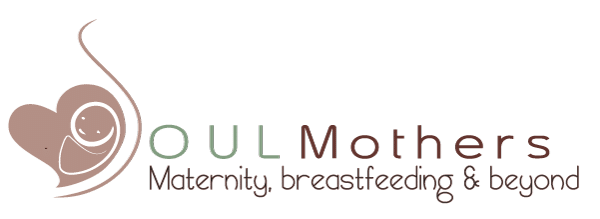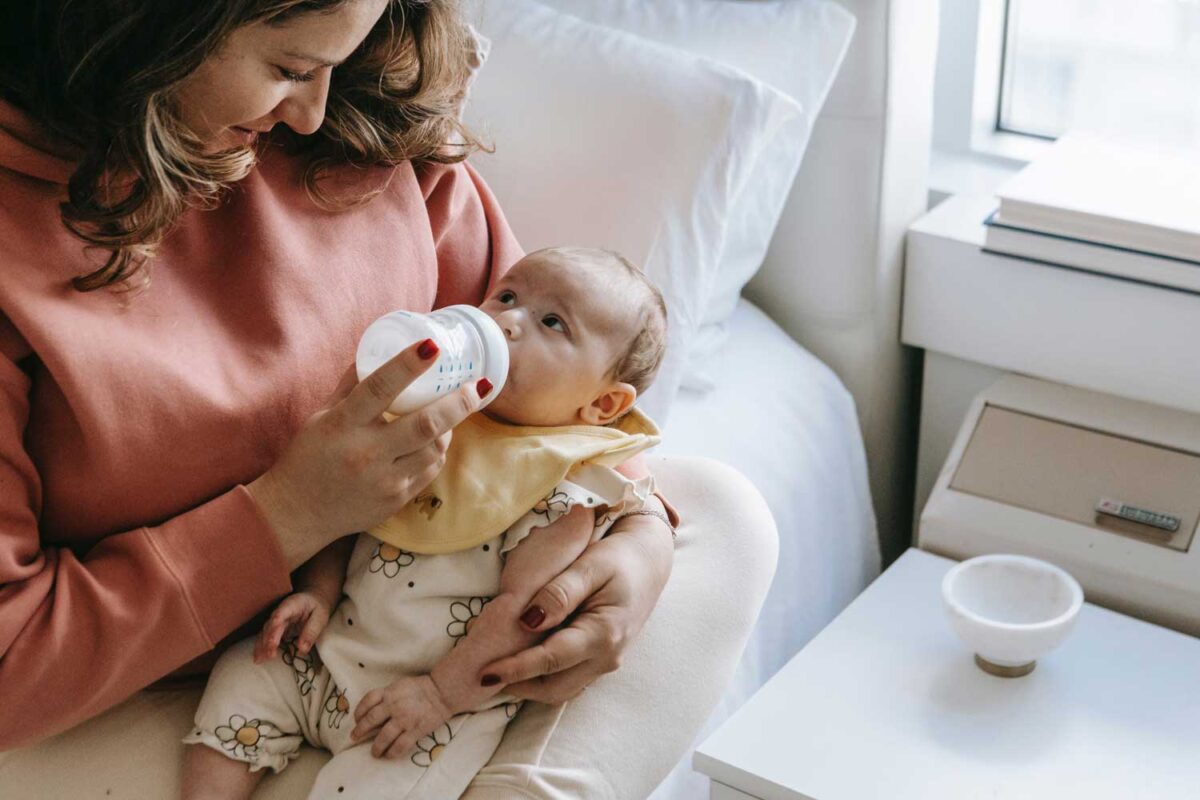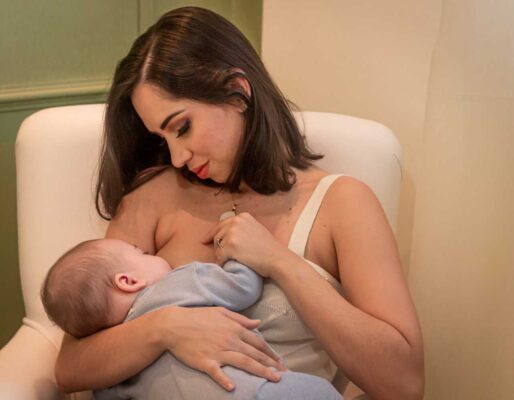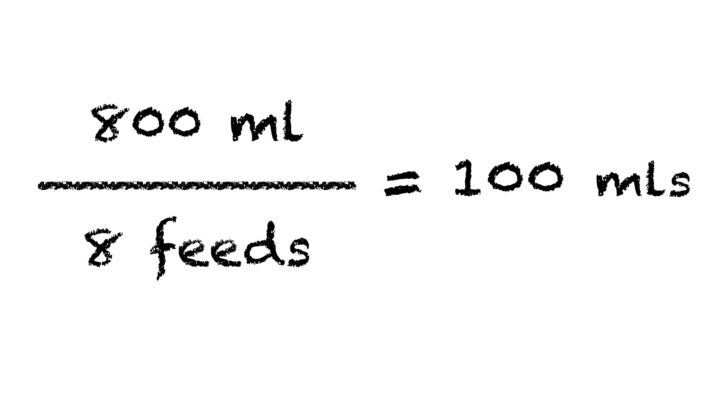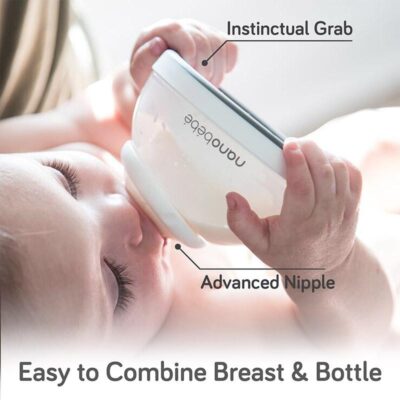Breastfeeding, Expressing & bottlefeeding
How much expressed breast milk do I feed my baby?
How much expressed breast milk do I feed my baby?
How much expressed breast milk do I feed my breastfed baby? This is the question every breastfeeding mum asks when needing to feed their baby expressed breast milk (EBM). But how do you work out how much to feed them?
Well of course is there is no magic amount to feed your baby. Every baby is different and how much they consume will be different from baby to baby. But that doesn’t mean that you can’t be prepared so that you don’t waste that precious gold.
Breastfed babies feed differently to formula fed babies
A lot of advice about bottle feeding comes from advice about formula feeding. Formula fed babies are generally fed larger feeds less often than breastfed babies. Formula takes longer to digest than breastmilk so babies will also feel full for longer.
Anyone who has, or is, breastfeeding knows that breastfed babies may feed frequently – up to hourly some days. These are generally smaller feeds. Providing larger EBM feeds can be wasteful as they may not drink it all. The remaining expressed milk has to be discarded if not consumed within 30 minutes.
Giving larger feeds can also interfere with milk supply as filling your baby up with a big feed will decrease their demand for breastfeeding. Once in a while this is ok, but if this is done daily, it will decrease demand for breastmilk. This may lead to a decrease in supply, at least for that time of the day.
Research into breastfed baby feeding patterns
A study of breastfeeding mothers and babies conducted by the University of Western Australia between 2000 and 2004, showed that the amount of breastmilk that a baby consumes daily is relatively stable. From one month to six months of age, exclusively breastfed babies consume an average of 800ml of breastmilk per day, with the range consumed by babies being 500ml to 1400ml. The range of milk consumed per feed was 60ml to 250ml.
To determine this the babies were weighed before and after feeding for a 24 hours period. An ultrasound was also performed on the mother’s breasts during feeds to monitor the feeding. Samples of the breastmilk were taken and studied to look at volume and composition.
nanobebe Breastmilk Bottle helps mimic the breast and ideal for breastfed babies when feeding EBM.
The study also showed that the average number of breastfeeds for a baby per day is 11, with the average amount per feed being 76 mls. 67% of babies feed 1-3 times per night. while 60% of the baby’s daily feed is consumed between 6am and 6pm.
Interestingly, this study also showed that boys consume more across the day than girls do, however they do not feed more frequently during the day. On average, boys consumed an average of 20ml more per feed than girls.
Now that we have all this information, how can we use it to determine the amount of EBM we should feed our baby?
How to calculate EBM feeds for your baby
Let’s start by looking at a simple calculation to get an idea as to how much milk our baby could be consuming per feed. We will use the average amount of breastmilk consumed per day – 800ml. Divide that by the average number of feeds per day – 11. This would give us an average of 72 mls which is consistent with the information we have. This is not a large feed, is it? It doesn’t seem like a lot and perhaps for your baby it isn’t. However, we can personalise this formula and tailor it to your baby.
Instead of using the average number of feeds per day, take note of how many feeds your baby is having per day. Maybe your baby averages 8 feeds a day. Then your baby’s average feed would be around 100 mls. This might seem like a reasonable amount to leave for your baby to consume while you are away from them.
Perhaps is you have boy, you could add 20 mls to this amount taking into account the research above. They may be consuming closer to 1000 mls per day, so it might make sense to you to allocate a bit more milk for your baby.
Take into account the daily activities and feeding patterns
Mum’s get to know when their babies have a big feed or a little feed and their babies tend to follow a pattern. This is helpful to know for when trying to work out how much breastmilk to warm up.
My babies always had a big feed first thing in the morning when there was more milk available. They would then not have another feed for a longer stretch than any other time of the day. Consider these patterns when you give your baby expressed breast milk as well so that you don’t waste any.
Leaving your breastfed baby with a carer
How long you are going to be separated from your baby is very relevant to the size of the feed. If you are popping out for a doctor’s appointment and leaving bub with their other parent or a family member for a couple of hours and they will only miss one feed, then they are more likely to have a smaller feed.
Dad feeding expressed breastmilk to newborn.
If you are going back to work and baby will be away from you for 8-10 hours per day, it is likely they will take fewer, but larger feeds with the carer than they do with mum. So in this instance they may take feeds of 125 – 180 ml.
Babies will feed differently for carers than they do with mum and they are smart enough to know the difference in feeding methods. But it is still important to ensure that the carer is not heating up too much EBM so leftovers don’t get tipped out.
Don’t heat up too much milk
By far the best way to manage how much milk to feed your baby is to start small. You are always better off heating up a smaller amount of milk and then heating up another amount if baby is still hungry. This can be annoying to heat a second amount but its far less wasteful of that liquid gold.
When leaving your baby for a few hours, use the calculation above dividing 800-1000 mls by the number of feeds per day. If your baby has 10 feeds a day, then you might want to leave 100ml of EBM. If it’s the first time you are leaving your baby, you might want to suggest that the person caring for your baby start by heating 60ml of milk and offering that amount to your baby. They may be satisfied after that feed, but some might want to take the rest.
Heating small amounts is a pain!
At first you will probably need to heat small amounts until you work out what size feeds your baby prefers. It’s a huge pain! The Jiffy Bottle warmer can help with this as its quick and easy to use, especially for small amounts.
jiffi Portable Bottle Warmer will assist you to warm and feed EBM while on the go!
Also remember that breastmilk only needs to heat to body temperature or slightly warmer. It does not need to be hot, in fact it will start to destroy all the goodness in breastmilk when the temperature reaches 55 C. So it shouldn’t take long to heat the EBM. The Jiffy Bottle Warmer wont let you heat higher than 50 C so its also a great way to preserve the nutrients in breastmilk.
More tips for feeding expressed breastmilk
Use smaller bottles. Generally breastfed babies will not take feeds of 200ml or more, so the smaller newborn bottles are sufficient. This makes it quicker to heat milk, more convenient for storage and for travelling.
How to avoid nipple confusion when bottle feeding a breastfed baby
Teats are usually graded by flow. Flow is usually newborn, 0-3 months or slow flow, 3-6 months or medium flow and 6 months+ or fast flow. A breastfed baby of any age does not really need a teat that flows faster than a newborn teat.
There is a reason for this. The baby is required to work for a breastfed, they need to suck to extract the milk. They will need to do this with a slow flow teat too. When you introduce a faster flowing teat, baby needs to do less work to access the milk.
nanobebe Breastmilk Bottle is easy for babies to hold on to for combined feeding.
It is human nature to go for the easier way to do things, so if you offer your baby an easy option, they might just decide that that’s what they want from now on and refuse the breast in preference for a faster flowing teat. This is known as ‘nipple confusion’.
Using the slow flow teat is one way to help prevent this issue. It also slows the feed so baby will consume what they need to fill them up rather than what is flowing from the teat.
There is no real sure way to determine exactly how much expressed milk to feed your breastfed baby. With these tips though, you should be able to work out how much to heat up enough so that you satisfy your baby without having to tip any of that precious gold down the sink!
